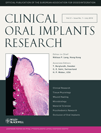Bone alterations at implant-supported FDPs in relation to inter-unit distances: a 5-year radiographic study
Abstract
Objectives: The aim of this 5-year study was to longitudinally evaluate bone alterations around implants with a conical implant–abutment interface in relation to implant–tooth and inter–implant distances.
Material and methods: The patient sample comprised 43 partially dentate patients with a total of 48 implant-supported fixed dental prostheses (FDPs) supported by 130 Astra Tech® implants. Following FDP placement (baseline), the patients were enrolled in an individually designed supportive care program. Radiographic examinations were performed at the time of FDP installation, 1 and 5 years of follow-up. Variables regarding implant position and proximal bone topography at tooth/implant units (n=36) and implant/implant units (n=67) were assessed with the use of a software program after scanning of the radiographs.
Results: At tooth/implant units, the mean 5-year marginal bone loss at the tooth, the implant and the mid-proximal bone crest was 0.1, 0.4 and 0.2 mm, respectively. The mean longitudinal bone loss at the implant/implant units was 0.5 mm at the implants and 0.3 mm mid-proximally. Multilevel regression analysis revealed that at implant/implant units, the change in the bone-to-implant contact level was a significant predictor with regard to the 5-year mid-proximal bone-level change, whereas the horizontal inter-unit distance showed a borderline significance (P=0.052). At tooth/implant units, no statistically significant associations were identified.
Conclusions: The results of this 5-year study revealed differences between inter-implant and tooth–implant proximal areas with regard to bone crest alterations and associated factors.
To cite this article: Chang M, Wennström JL. Bone alterations at implant-supported FDPs in relation to inter-unit distances: a 5-year radiographic study.Clin. Oral Impl. Res. 21, 2010; 735–740.doi: 10.1111/j.1600-0501.2009.01893.x




